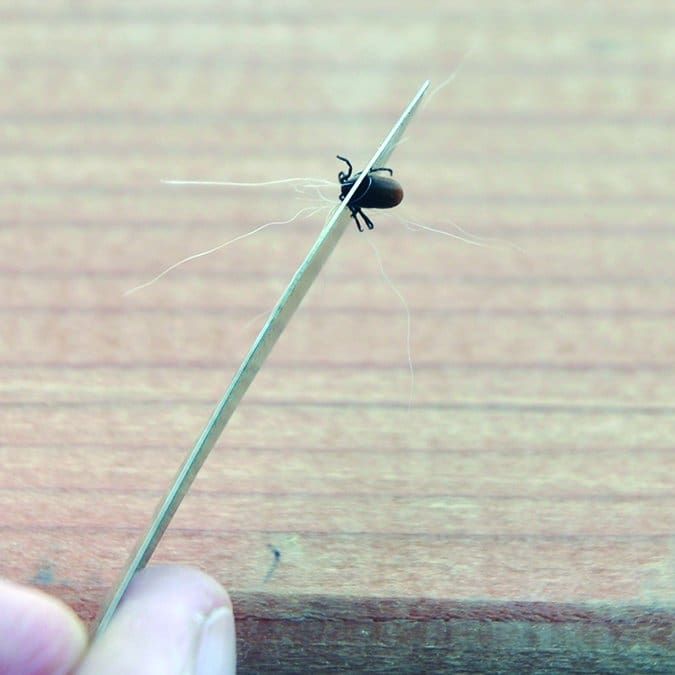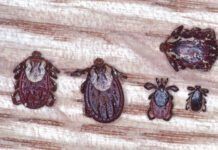It’s hard to say which is worse: running your hand over your dog and brushing against an attached tick, or seeing a tick skitter across your dog’s face. Either way, the unwelcome arachnid must go. What should you do?

1. Remove the tick.
If it is walking on your dog, you can grab it with your fingers or use something like a paper towel if you don’t want to touch it. If it is attached, you will need to pull it off, making sure that you get the head out of your dog’s skin.
There are a variety of tick removers on the market that work well (our favorite is the Pro-Tick Remedy, pictured here). Keep your tick remover somewhere you can easily find it when needed, and read the directions on the package for best results.
If you do not have a tick-remover tool, tweezers will do the trick. Grip the tick’s head as close to your dog’s skin as possible and slowly pull it out using steady pressure. Don’t tear quickly, or you could leave the tick’s head behind, which still leaves your dog at risk for contracting a tick-borne disease.
I always flush any ticks that I find to be sure that they are out of my house and space. You can also drown them or put them in the trash in a sealed container (just in case they aren’t actually dead). Burning them with a lighter can be satisfying; just do not try to burn the tick while it is still on your dog!
You can also save the tick in a sealed container to show to your veterinarian for identification purposes or to submit for Lyme-disease testing.
2. Clean the bite area.
Plain old soap and water will work fine, or you can use an alcohol wipe. Cleaning the wound, no matter how small, reduces the risk of secondary bacterial infection.
3. Check for more ticks.
Where there is one tick, there could easily be more. Go over your dog’s entire body checking for any more eight-legged stowaways, including in his armpits, around his face, and in his ears. A fine-tooth comb can be very useful for getting through a longhaired dog’s coat and will catch larger ticks. Also check yourself and any other pets that were in the area where your dog most likely got the tick.
4. Review your preventatives.
Is your dog on a regular flea and tick preventative? If not, this would be a good time to start. There are a wide variety of options, including topicals, collars, and oral medications. The fleas and ticks in some areas are becoming resistant to some preventives, so even if you have been using a preventative regularly, it may be necessary to switch if you are seeing a significant increase in ticks on your dog.
Consult with your veterinarian before choosing a product to make sure that it will fit your situation. No matter which product you choose, be aware that the vast majority do not actually repel ticks and may require the tick to bite to kill it. Ticks have to be attached for a period of time before tick-borne diseases are transmitted, so killing the tick quickly reduces your dog’s risk.
5. Schedule blood work to check for tick-borne diseases.
It takes several weeks for most tick-borne diseases to be detectable on blood tests, so there is no need to rush to the vet unless your dog starts to show clinical signs of illness. The most common tick-borne diseases that affect dogs can all cause fevers, lethargy, and lameness.
If you live in an area with lots of ticks, screening for tick-borne diseases is a good thing to do as part of your dog’s annual appointment to catch any developing issues before they become a major problem. If your dog does become ill or is acting off, mention to your veterinarian that he was bitten by a tick.
Kate Eldredge is a licensed veterinary technician from Plattsburgh, New York. She also trains, shows, and breeds Belgian Tervuren and is working on her canine-rehabilitation certification.







Thank you for the instruction s.
Last year I brought a tick that had been on my dog to my vet. It was in a zip lock bag. She said they were very hard to kill and to put some oil in the bag and that would suffocate it. I don’t know but flushing it down the toilet might not kill it because on a septic system could it leach out and survive?